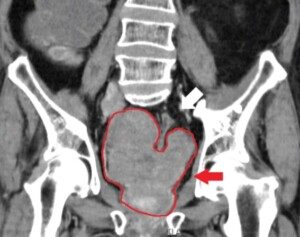
Should a woman with an intellectual disability be put on GLP-1 therapy if she’s morbidly obese and has no chance of losing weight on her own?
“Kelcie” is 302 pounds; she had weighed herself and told me.
I’ve taken her into the community twice a week, and she definitely has quite the appetite.
She’s told me her mother wants her to lose weight.
At 30, Kelcie can still walk pretty decently, but uses a walker due to unexpected dizziness and feeling faint from a migraine disorder.
The only exercise she gets is an occasional 30 minutes of easy stationary bike pedaling – when she’s up to it, and when I’m available to take her to the gym, using the gym card from the support agency.
Kelcie has no insight into how serious her condition is. When she says, “My mom wants me to lose weight,” her demeanor is blasé and matter of fact, suggesting she’s just going along with what her mother wants with little awareness, if at all, of just how dangerous severe obesity is.
Often, a young adult with significant overweight will continue gaining well into middle age if they haven’t been making ongoing attempts to lose weight.
Kelcie will likely be debilitated by her heaviness (most of the weight is in her middle, which is the most adverse type of fat distribution) by the time she’s 40, especially if she keeps using a walker everywhere because she’s too heavy and deconditioned to prevent a fall if she suddenly feels dizzy.
A fit and much lighter-weight individual could quickly take measures to prevent a fall at the first sign of dizziness or feeling faint, by scrambling to the nearest chair or something to lean on, or deftly getting on all fours and waiting out the spell.
In fact, one day I actually instructed Kelcie, who was in a roomy handicap restroom stall, to get on all fours to ambulate from the toilet to the door to unlock it so that I could gain access to be at her side because she was afraid to leave the toilet due to fear of passing out.
I entered; she was still on all fours. When it was time to get back on her feet, even with a hand on the walker, she had clear difficulty — due to her size.
Kelcie is so large that she can’t effectively conduct pre-emptive actions when she feels off-kilter, and thus must rely on the walker, which cheats her lower body including core from normal movement. This alone could be costly long-term.
I asked her why she doesn’t have a YMCA membership, since she’s expressed interest in taking a yoga class there, which we can’t do because it begins before her day program does.
She said she doesn’t have the money. She gets a disability check. Her mother gets paid by Medicaid to care for her. Her stepfather works. THE MONEY IS THERE.
It’s just that her parents don’t think a gym membership for their morbidly obese daughter is important.
I have also worked with another similar-size woman from the agency, but her intellectual disability puts her cognitive skills at around 11 or 12 years of age – high enough to lose 75 pounds on her own – from 320 to 245. And she’s still working on her goal.
By my estimation, Kelcie’s mental age is around eight or nine – she lacks the cognitive bandwidth to lose weight on her own.
Would it be unethical to get a special needs woman on a GLP-1 to lose weight?
This isn’t about vanity or looks. It’s about health and what all that weight will do to her future mobility, heart, kidneys and liver.
How did Kelcie get so big?
I don’t know what happened in her childhood, but it’s quite possible that her duo diagnosis of intellectual impairment and autism (two distinct conditions; one does not cause the other) led to her parents overfeeding her – lots of sugary food can make a frustrated or struggling child very happy in that moment … and very quickly.
Maybe food was used as a reward for achieving tasks that typical kids learn at earlier ages.
Perhaps Kelcie was placated or soothed with classic comfort foods when she became upset or sad, or when she became distressed over unexpected outcomes; ultra-processed food was always there to make her feel better. And plenty of it.
She became so used to being overfed that now, as an adult, it’s a point of no return, being that she functions at an eight-year-old level. Cue the GLP-1.
Studies on GLP-1 Use for Weight Loss in Special Needs Populations
“Special needs” typically refers to conditions such as intellectual disability, a cognitive impairment from head trauma, a “developmental disability” from a genetic condition (which usually also causes a low IQ), and autism.
There do not exist well‐designed studies (e.g., randomized controlled trials) that precisely match this population as far as use of GLP-1 drugs to assist with weight loss.
But it certainly wouldn’t be a reach to assume that somewhere out there, a physician has prescribed a GLP-1 for a morbidly obese individual with a lower functioning form of ID or autism.
There are some individuals with subnormal IQs or very minimal-support-needs autism who’ve probably, on their very own, sought out GLP-1 therapy for morbid obesity or even moderate obesity – and have gotten the prescription.
In fact, it’s very possible that in many of these cases, particularly low-support-needs autism (which can easily be concealed or go undetected during doctor visits), that the physician had no idea that their patient had a so-called developmental disability.
Some people with ID or autism can be quite self-advocating, and won’t necessarily disclose their condition to their primary care physician.
So with that said, it’s extremely likely that out of the hundreds of thousands of Americans on a GLP-1 for weight loss, a very small percentage would fit the criteria for an intellectual handicap or autism spectrum.
There are no studies on this subset of GLP-1 users.
Reasons could be as follows, based on logic:
- Some of the autistic patients don’t know they’re autistic (I myself didn’t know it until late in middle age).
- The ones with a subnormal IQ who might be in a study for semaglutide effectiveness wouldn’t feel a need to disclose this condition since it would have nothing to do with the aim of the study.
- Those who have an autism diagnosis wouldn’t disclose this for the same reason.
So it’s possible that these much higher functioning patients have, indeed, been participants in GLP-1 studies, but these would have been studies unrelated to their cognitive diagnosis.
What about lower functioning people and GLP-1’s?
Most of what we know about these game-changing medications comes from studies in the general population – or what may seem like the general population.
For example, if I myself were obese and wanted to participate in a study on a new type of GLP-1 for weight loss, I’d feel absolutely no need to disclose my Level 1 autism diagnosis.
And it’s also possible that somewhere out there, a woman with a daughter like Kelcie has convinced a doctor to prescribe a GLP-1 for her daughter – with Mom administering the injections.
Nevertheless, there really should be studies for lower functioning special needs adults regarding use of GLP-1’s for morbid obesity.
Morbid obesity is disproportionately present in this population.
Some might respond differently to these drugs, and they may have other health issues or challenges that affect how well the treatment works.
Safety is important too; GLP‑1 drugs can cause stomach problems, and some side effects might be harder to notice or manage if the person has trouble communicating.
Lifestyle support is still key — things like diet changes and physical activity help the drug work better, but these often need to be adapted to fit the person’s abilities and routines.
Sticking with the treatment can be tricky even for people without a cognitive deficit, so having caregivers involved and making it easy to follow the plan is crucial.
Finally, many intellectually disabled adults, or those with autism, take other medications or have health conditions that can make weight management more complicated, so all of that has to be considered before starting therapy.
Is it ethical?
Well, let’s look at it this way: Kelcie and those like her are headed for doom if that weight doesn’t come off.
It would be highly unethical to allow her to continue living with such severe obesity which will at some point begin causing ongoing aches and pains (it’s already causing acid reflux and hypertension), likely sleep apnea, and predictably type 2 diabetes and heart problems – not to mention mobility impairment.
If a GLP-1 is what it’d take to knock her weight down, save her health and yield higher quality to her life – then this sounds like the smartest plan in the name of her current and future health and mobility.
![]()









































